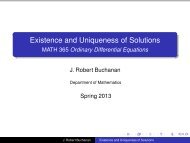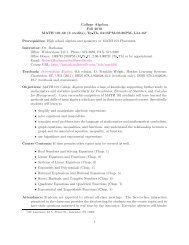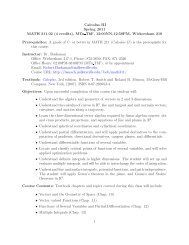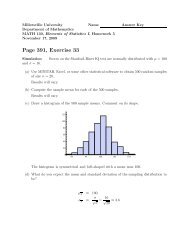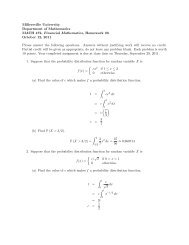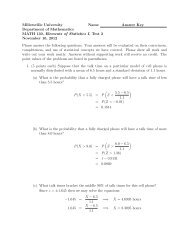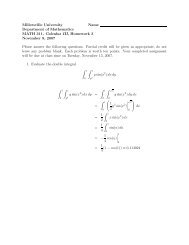Elementary Matrices
Elementary Matrices
Elementary Matrices
You also want an ePaper? Increase the reach of your titles
YUMPU automatically turns print PDFs into web optimized ePapers that Google loves.
<strong>Elementary</strong> <strong>Matrices</strong><br />
MATH 322, Linear Algebra I<br />
J. Robert Buchanan<br />
Department of Mathematics<br />
Spring 2007<br />
J. Robert Buchanan <strong>Elementary</strong> <strong>Matrices</strong>
Outline<br />
Today’s discussion will focus on:<br />
elementary matrices and their properties,<br />
using elementary matrices to find the inverse of a matrix (if<br />
the inverse exists),<br />
properties of invertible matrices.<br />
J. Robert Buchanan <strong>Elementary</strong> <strong>Matrices</strong>
<strong>Elementary</strong> <strong>Matrices</strong><br />
Definition<br />
An n × n matrix is an elementary matrix if it can be obtained<br />
from In by a single elementary row operation.<br />
Example<br />
E is a 2 × 2 elementary matrix formed by swapping the two<br />
rows of I2.<br />
<br />
0<br />
E =<br />
1<br />
<br />
1<br />
0<br />
Note the effect it has upon multiplying an arbitrary matrix.<br />
<br />
0<br />
1<br />
<br />
1 a11<br />
0<br />
a12 a13<br />
<br />
a21<br />
=<br />
a22 a23<br />
<br />
a21 a22 a23<br />
J. Robert Buchanan <strong>Elementary</strong> <strong>Matrices</strong><br />
a11 a12 a13
<strong>Elementary</strong> <strong>Matrices</strong><br />
Definition<br />
An n × n matrix is an elementary matrix if it can be obtained<br />
from In by a single elementary row operation.<br />
Example<br />
E is a 2 × 2 elementary matrix formed by swapping the two<br />
rows of I2.<br />
<br />
0<br />
E =<br />
1<br />
<br />
1<br />
0<br />
Note the effect it has upon multiplying an arbitrary matrix.<br />
<br />
0<br />
1<br />
<br />
1 a11<br />
0<br />
a12 a13<br />
<br />
a21<br />
=<br />
a22 a23<br />
<br />
a21 a22 a23<br />
J. Robert Buchanan <strong>Elementary</strong> <strong>Matrices</strong><br />
a11 a12 a13
Left Multiplication by E<br />
Theorem<br />
If E is an elementary matrix obtained from Im by performing a<br />
certain elementary row operation and if A is an m × n matrix<br />
then EA is the matrix that results from performing the same<br />
elementary row operation on A.<br />
Example<br />
Let A =<br />
E2 =<br />
⎡<br />
⎣<br />
⎡<br />
⎣<br />
1 2 3<br />
4 5 6<br />
7 8 9<br />
1 1 0<br />
0 1 0<br />
0 0 1<br />
and calculate E1A, E2A, and E3A.<br />
⎤<br />
⎡<br />
⎦ , E1 = ⎣<br />
⎤<br />
⎡<br />
⎦ , E3 = ⎣<br />
J. Robert Buchanan <strong>Elementary</strong> <strong>Matrices</strong><br />
1 0 0<br />
0 2 0<br />
0 0 1<br />
1 0 0<br />
0 0 1<br />
0 1 0<br />
⎤<br />
⎦ ,<br />
⎤<br />
⎦ ,
Left Multiplication by E<br />
Theorem<br />
If E is an elementary matrix obtained from Im by performing a<br />
certain elementary row operation and if A is an m × n matrix<br />
then EA is the matrix that results from performing the same<br />
elementary row operation on A.<br />
Example<br />
Let A =<br />
E2 =<br />
⎡<br />
⎣<br />
⎡<br />
⎣<br />
1 2 3<br />
4 5 6<br />
7 8 9<br />
1 1 0<br />
0 1 0<br />
0 0 1<br />
and calculate E1A, E2A, and E3A.<br />
⎤<br />
⎡<br />
⎦ , E1 = ⎣<br />
⎤<br />
⎡<br />
⎦ , E3 = ⎣<br />
J. Robert Buchanan <strong>Elementary</strong> <strong>Matrices</strong><br />
1 0 0<br />
0 2 0<br />
0 0 1<br />
1 0 0<br />
0 0 1<br />
0 1 0<br />
⎤<br />
⎦ ,<br />
⎤<br />
⎦ ,
Inverse Operations<br />
Every elementary row operation has an inverse elementary row<br />
operation.<br />
Operation Inverse<br />
Multiply row i by c = 0 Multiply row i by 1/c<br />
Swap rows i and j Swap rows i and j<br />
Add c times row i to row j Add −c times row i to row j<br />
Example<br />
⎡<br />
Let E1 = ⎣<br />
1 0 0<br />
0 2 0<br />
0 0 1<br />
⎤<br />
⎡<br />
⎦ , E2 = ⎣<br />
1 1 0<br />
0 1 0<br />
0 0 1<br />
⎤<br />
⎡<br />
⎦, E3 = ⎣<br />
and find the corresponding inverse operations.<br />
J. Robert Buchanan <strong>Elementary</strong> <strong>Matrices</strong><br />
1 0 0<br />
0 0 1<br />
0 1 0<br />
⎤<br />
⎦ ,
Inverse Operations<br />
Every elementary row operation has an inverse elementary row<br />
operation.<br />
Operation Inverse<br />
Multiply row i by c = 0 Multiply row i by 1/c<br />
Swap rows i and j Swap rows i and j<br />
Add c times row i to row j Add −c times row i to row j<br />
Example<br />
⎡<br />
Let E1 = ⎣<br />
1 0 0<br />
0 2 0<br />
0 0 1<br />
⎤<br />
⎡<br />
⎦ , E2 = ⎣<br />
1 1 0<br />
0 1 0<br />
0 0 1<br />
⎤<br />
⎡<br />
⎦, E3 = ⎣<br />
and find the corresponding inverse operations.<br />
J. Robert Buchanan <strong>Elementary</strong> <strong>Matrices</strong><br />
1 0 0<br />
0 0 1<br />
0 1 0<br />
⎤<br />
⎦ ,
Invertibility<br />
Theorem<br />
Every elementary matrix is invertible and the inverse is also an<br />
elementary matrix.<br />
Proof.<br />
J. Robert Buchanan <strong>Elementary</strong> <strong>Matrices</strong>
Invertibility<br />
Theorem<br />
Every elementary matrix is invertible and the inverse is also an<br />
elementary matrix.<br />
Proof.<br />
J. Robert Buchanan <strong>Elementary</strong> <strong>Matrices</strong>
Equivalence Result<br />
Theorem<br />
If A is an n × n matrix, then the following statements are<br />
equivalent:<br />
1 A is invertible.<br />
2 Ax = 0 has only the trivial solution.<br />
3 The reduced row echelon form of A is In.<br />
4 A is expressible as the product of elementary matrices.<br />
J. Robert Buchanan <strong>Elementary</strong> <strong>Matrices</strong>
Equivalence Result<br />
Theorem<br />
If A is an n × n matrix, then the following statements are<br />
equivalent:<br />
1 A is invertible.<br />
2 Ax = 0 has only the trivial solution.<br />
3 The reduced row echelon form of A is In.<br />
4 A is expressible as the product of elementary matrices.<br />
Proof.<br />
1 =⇒ 2<br />
J. Robert Buchanan <strong>Elementary</strong> <strong>Matrices</strong>
Equivalence Result<br />
Theorem<br />
If A is an n × n matrix, then the following statements are<br />
equivalent:<br />
1 A is invertible.<br />
2 Ax = 0 has only the trivial solution.<br />
3 The reduced row echelon form of A is In.<br />
4 A is expressible as the product of elementary matrices.<br />
Proof.<br />
1 =⇒ 2 =⇒ 3<br />
J. Robert Buchanan <strong>Elementary</strong> <strong>Matrices</strong>
Equivalence Result<br />
Theorem<br />
If A is an n × n matrix, then the following statements are<br />
equivalent:<br />
1 A is invertible.<br />
2 Ax = 0 has only the trivial solution.<br />
3 The reduced row echelon form of A is In.<br />
4 A is expressible as the product of elementary matrices.<br />
Proof.<br />
1 =⇒ 2 =⇒ 3 =⇒ 4<br />
J. Robert Buchanan <strong>Elementary</strong> <strong>Matrices</strong>
Equivalence Result<br />
Theorem<br />
If A is an n × n matrix, then the following statements are<br />
equivalent:<br />
1 A is invertible.<br />
2 Ax = 0 has only the trivial solution.<br />
3 The reduced row echelon form of A is In.<br />
4 A is expressible as the product of elementary matrices.<br />
Proof.<br />
1 =⇒ 2 =⇒ 3 =⇒ 4 =⇒ 1<br />
J. Robert Buchanan <strong>Elementary</strong> <strong>Matrices</strong>
Row Equivalence<br />
Definition<br />
If matrix B can be obtained from matrix A by a finite sequence<br />
of elementary row operations then A and B are said to be row<br />
equivalent.<br />
Remark: An n × n matrix A is invertible if and only if A is row<br />
equivalent to In.<br />
J. Robert Buchanan <strong>Elementary</strong> <strong>Matrices</strong>
Row Equivalence<br />
Definition<br />
If matrix B can be obtained from matrix A by a finite sequence<br />
of elementary row operations then A and B are said to be row<br />
equivalent.<br />
Remark: An n × n matrix A is invertible if and only if A is row<br />
equivalent to In.<br />
J. Robert Buchanan <strong>Elementary</strong> <strong>Matrices</strong>
Matrix Inversion Algorithm<br />
Algorithm: to find the inverse of an invertible matrix A, find the<br />
set of elementary row operations which reduces A to I and then<br />
perform this same sequence of operations on I to produce A −1 .<br />
Example<br />
⎡<br />
Find the inverse of A = ⎣<br />
8 1 5<br />
2 −7 −1<br />
3 4 1<br />
⎤<br />
⎦.<br />
J. Robert Buchanan <strong>Elementary</strong> <strong>Matrices</strong>
Matrix Inversion Algorithm<br />
Algorithm: to find the inverse of an invertible matrix A, find the<br />
set of elementary row operations which reduces A to I and then<br />
perform this same sequence of operations on I to produce A −1 .<br />
Example<br />
⎡<br />
Find the inverse of A = ⎣<br />
8 1 5<br />
2 −7 −1<br />
3 4 1<br />
⎤<br />
⎦.<br />
J. Robert Buchanan <strong>Elementary</strong> <strong>Matrices</strong>
Example<br />
Example<br />
⎡<br />
Find the inverse of A = ⎣<br />
2 −1 0<br />
4 5 −3<br />
1 −4 3<br />
2<br />
⎤<br />
⎦.<br />
J. Robert Buchanan <strong>Elementary</strong> <strong>Matrices</strong>
Homework<br />
Read Section 1.5 and work exercises 1–6, 8, 9, 11, 15.<br />
J. Robert Buchanan <strong>Elementary</strong> <strong>Matrices</strong>



